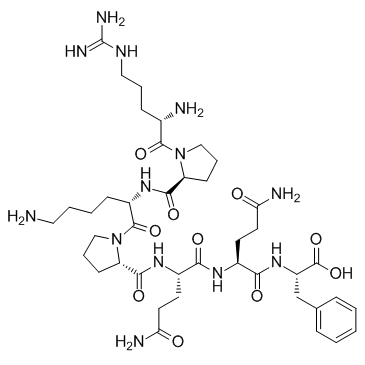Inhibition of ERK phosphorylation by substance P N-terminal fragment decreases capsaicin-induced nociceptive response.
Takaaki Komatsu, Hirokazu Mizoguchi, Mika Sasaki, Chikai Sakurada, Minoru Tsuzuki, Shinobu Sakurada, Tsukasa Sakurada
Index: Neuropharmacology 61 , 608-613, (2011)
Full Text: HTML
Abstract
Previous research has demonstrated that substance P N-terminal fragments produced by the action of several different enzymes in the spinal cord could reduce nociception when injected intrathecally (i.t.) into mice. The present study examined the possible involvement of spinal extracellular signal-regulated protein kinase (ERK), a mitogen-activated protein kinase (MAPK), in i.t. substance P (1-7)-induced antinociception as assayed by the capsaicin test. The i.t. injection of substance P (1-7) (20-80 nmol) into mice resulted in a dose-dependent attenuation of paw-licking/biting behavior induced by intraplantar injection of capsaicin, which was reversed by co-injection of [D-Pro(2), D-Phe(7)]substance P (1-7), a D-isomer and antagonist of substance P (1-7). In Western blot analysis, intraplantar injection of capsaicin (400 and 1600 ng/paw) produced an increase of ERK phosphorylation in the dorsal spinal cord, whereas expression of p38 and c-Jun N-terminal kinase (JNK) phosphorylation was unchanged by capsaicin treatment. In parallel to the behavioral results, i.t. substance P (1-7) inhibited capsaicin-induced ERK phosphorylation, which was reversed by [D-Pro(2), D-Phe(7)]substance P (1-7), a substance P (1-7) antagonist. Both nociceptive behavioral response and spinal ERK activation induced by intraplantar capsaicin were reduced by U0126, an upstream inhibitor of ERK phosphorylation. Taken together, these findings suggest that the activation of ERK, but not p38 and JNK MAPKs in the spinal cord, contributes to intraplantar capsaicin-induced nociception, and that blocking ERK activation via substance P (1-7) binding sites may provide significant antinociception at the spinal cord level.Copyright © 2011 Elsevier Ltd. All rights reserved.
Related Compounds
| Structure | Name/CAS No. | Molecular Formula | Articles |
|---|---|---|---|
 |
Substance P (1-7)
CAS:68060-49-1 |
C41H65N13O10 |
|
Effects of L-glutamate, substance P and substance P(1-7) on ...
1993-07-02 [Regul. Pept. 46 , 102, (1993)] |
|
Endomorphin-1 and endomorphin-2 differentially interact with...
2006-04-01 [Peptides 27 , 753-759, (2006)] |
|
Substance P(1-7) induces antihyperalgesia in diabetic mice t...
2010-01-25 [Eur. J. Pharmacol. 626 , 250-255, (2010)] |
|
The C-terminal amidated analogue of the substance P (SP) fra...
2009-12-01 [Peptides 30 , 2418-2422, (2009)] |
|
The substance P (SP) heptapeptide fragment SP1-7 alters the ...
2004-11-01 [Peptides 25 , 1951-1957, (2004)] |